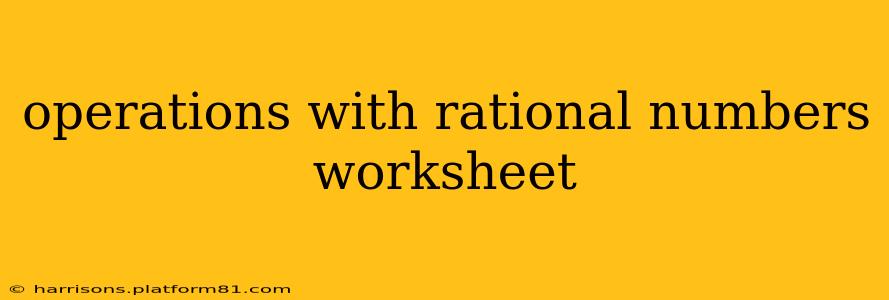This worksheet guide delves into the intricacies of performing operations with rational numbers. Rational numbers encompass all numbers that can be expressed as a fraction p/q, where p and q are integers, and q is not zero. This includes integers, fractions, terminating decimals, and repeating decimals. Mastering these operations is crucial for success in algebra and beyond. We'll cover addition, subtraction, multiplication, and division, addressing common pitfalls and providing practical examples to solidify your understanding.
Understanding Rational Numbers
Before diving into operations, let's ensure a solid grasp of what constitutes a rational number. Remember, any number that can be written as a fraction of two integers (where the denominator isn't zero) is a rational number. This includes:
- Integers: Whole numbers (positive, negative, and zero). Example: -3, 0, 5
- Fractions: Numbers expressed as a ratio of two integers. Example: 1/2, -3/4, 7/1
- Terminating Decimals: Decimals that end. Example: 0.25, -1.75, 3.0
- Repeating Decimals: Decimals with a pattern that repeats infinitely. Example: 0.333..., 0.142857142857...
Addition and Subtraction of Rational Numbers
Adding and subtracting rational numbers requires a common denominator. If the denominators are already the same, simply add or subtract the numerators and keep the denominator. If the denominators are different, find the least common multiple (LCM) of the denominators and convert the fractions to equivalent fractions with that common denominator.
Example:
Add 1/3 + 2/5
- Find the LCM of 3 and 5 (which is 15)
- Convert the fractions: (1/3) * (5/5) = 5/15 and (2/5) * (3/3) = 6/15
- Add the numerators: 5/15 + 6/15 = 11/15
Example:
Subtract 3/4 - 1/2
- Find the LCM of 4 and 2 (which is 4)
- Convert the fractions: 3/4 remains the same, and (1/2) * (2/2) = 2/4
- Subtract the numerators: 3/4 - 2/4 = 1/4
What are the different methods for adding and subtracting rational numbers?
There are two primary methods: finding a common denominator (as demonstrated above) and converting to decimals (if the decimals are terminating or easily manageable). The common denominator method is generally preferred for its accuracy and applicability to all rational numbers. Converting to decimals can be faster for some simple fractions but introduces rounding errors with repeating decimals.
Multiplication and Division of Rational Numbers
Multiplying rational numbers is straightforward: multiply the numerators together and the denominators together. Simplify the resulting fraction if possible.
Example:
Multiply (2/3) * (4/5) = (24)/(35) = 8/15
Dividing rational numbers involves multiplying by the reciprocal of the second fraction. The reciprocal of a fraction is obtained by swapping the numerator and the denominator.
Example:
Divide (1/2) / (3/4) = (1/2) * (4/3) = 4/6 = 2/3
How do you simplify the results of operations with rational numbers?
Simplification involves reducing the fraction to its lowest terms by dividing both the numerator and the denominator by their greatest common divisor (GCD). For instance, 4/6 simplifies to 2/3 because the GCD of 4 and 6 is 2.
Working with Mixed Numbers
Mixed numbers (e.g., 2 1/2) need to be converted to improper fractions before performing operations. To convert a mixed number to an improper fraction, multiply the whole number by the denominator, add the numerator, and keep the same denominator. For example, 2 1/2 becomes (2*2 + 1)/2 = 5/2.
How do you convert mixed numbers to improper fractions and vice versa?
As mentioned above, to convert a mixed number to an improper fraction, multiply the whole number by the denominator, add the numerator, and keep the same denominator. To convert an improper fraction to a mixed number, divide the numerator by the denominator. The quotient becomes the whole number, the remainder becomes the new numerator, and the denominator stays the same.
Practice Problems
Now, let's put your knowledge into practice! Try these problems:
- 1/4 + 3/8 = ?
- 2/3 - 1/6 = ?
- (5/7) * (14/15) = ?
- (3/4) / (1/2) = ?
- 1 1/3 + 2 1/2 = ?
- 3 1/4 - 1 2/3 = ?
This worksheet provides a foundation for understanding operations with rational numbers. Remember to practice regularly to solidify your skills. With consistent effort, mastering these concepts will significantly enhance your mathematical abilities.
